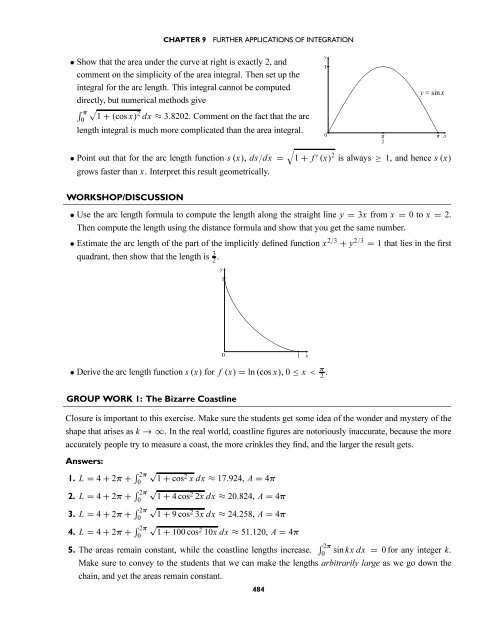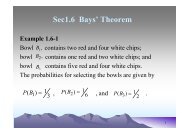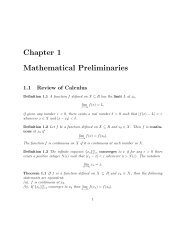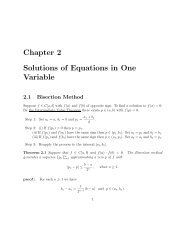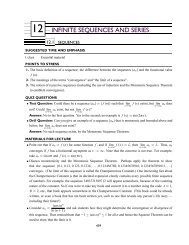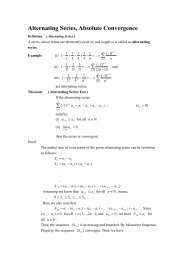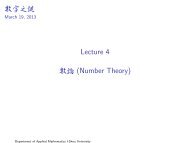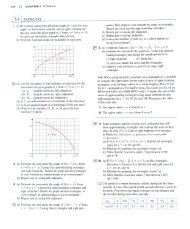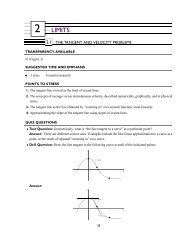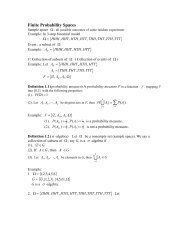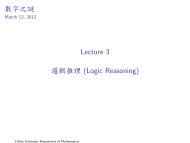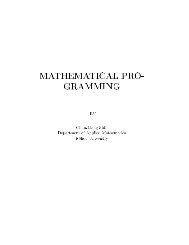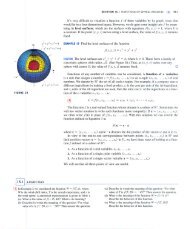9 FURTHER APPLICATIONS OF INTEGRATION
9 FURTHER APPLICATIONS OF INTEGRATION
9 FURTHER APPLICATIONS OF INTEGRATION
You also want an ePaper? Increase the reach of your titles
YUMPU automatically turns print PDFs into web optimized ePapers that Google loves.
CHAPTER 9<br />
<strong>FURTHER</strong> <strong>APPLICATIONS</strong> <strong>OF</strong> <strong>INTEGRATION</strong><br />
• Show that the area under the curve at right is exactly 2, and<br />
comment on the simplicity of the area integral. Then set up the<br />
integral for the arc length. This integral cannot be computed<br />
directly, but numerical methods give<br />
∫ π<br />
√<br />
0 1 + (cos x) 2 dx ≈ 3.8202. Comment on the fact that the arc<br />
length integral is much more complicated than the area integral.<br />
• Point out that for the arc length function s (x), ds/dx =<br />
grows faster than x. Interpret this result geometrically.<br />
√<br />
1 + f ′ (x) 2 is always ≥ 1, and hence s (x)<br />
WORKSHOP/DISCUSSION<br />
• Use the arc length formula to compute the length along the straight line y = 3x from x = 0tox = 2.<br />
Then compute the length using the distance formula and show that you get the same number.<br />
• Estimate the arc length of the part of the implicitly defined function x 2/3 + y 2/3 = 1thatliesinthefirst<br />
quadrant, then show that the length is 3 2 . y<br />
1<br />
0<br />
• Derive the arc length function s (x) for f (x) = ln (cos x),0≤ x < π 2 .<br />
1 x<br />
GROUP WORK 1: The Bizarre Coastline<br />
Closure is important to this exercise. Make sure the students get some idea of the wonder and mystery of the<br />
shape that arises as k →∞. In the real world, coastline figures are notoriously inaccurate, because the more<br />
accurately people try to measure a coast, the more crinkles they find, and the larger the result gets.<br />
Answers:<br />
1. L = 4 + 2π + ∫ 2π<br />
√<br />
0 1 + cos 2 xdx≈ 17.924, A = 4π<br />
2. L = 4 + 2π + ∫ 2π<br />
√<br />
0 1 + 4cos 2 2xdx≈ 20.824, A = 4π<br />
3. L = 4 + 2π + ∫ 2π<br />
√<br />
0 1 + 9cos 2 3xdx≈ 24.258, A = 4π<br />
4. L = 4 + 2π + ∫ 2π<br />
√<br />
0 1 + 100 cos 2 10xdx≈ 51.120, A = 4π<br />
∫ 2π<br />
5. The areas remain constant, while the coastline lengths increase.<br />
0<br />
sin kx dx = 0 for any integer k.<br />
Make sure to convey to the students that we can make the lengths arbitrarily large as we go down the<br />
chain, and yet the areas remain constant.<br />
484


